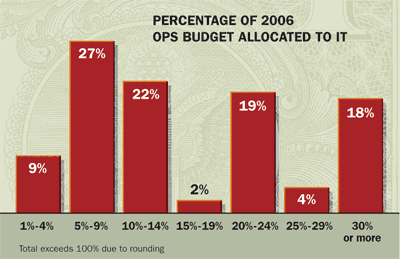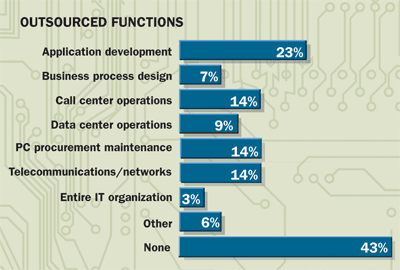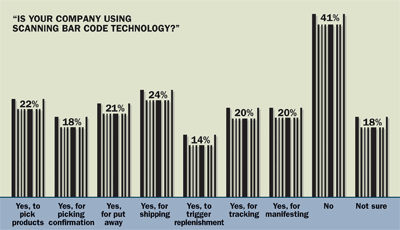Here’s an encouraging statistic from Multichannel Merchant’s 2006 Information Technology Systems Benchmark Report: More than 70% of respondents said that upgrading systems was one of their most significant IT accomplishments of the past 12 months. Could it be that multichannel merchants are coming around to the fact that spending on technology can help set them apart from their competition? Perhaps.
Equally encouraging is that IT enhancements are not solely the domain of the big boys: More than three-quarters of respondents with annual sales of $10 million-$49.9 million rated systems upgrades as their most significant accomplishment.

Then again, consider that 31% of respondents said cutting IT costs was the most significant accomplishment.
Speaking of spending, little has changed in the allocation of IT spending in a company’s overall operations budget. The plurality of this year’s respondents — 27% — allocated 5%-9% of their ops budget to IT spending, which is unchanged from 2004, when we last conducted an Information Technology Systems survey. Another 22% said that IT spending accounted for 10%-14% of their operations budget, down slightly from the 2004 figure of 25%. Fewer than half of respondents allocated 15% or more of their ops budget to IT.
Overall, a mean 18.3% of respondents’ operations budgets were allocated to IT. Among the largest survey participants, those with annual sales of at least $50 million, a mean 14.2% was allocated. The smallest respondents, those with sales of less than $10 million, budgeted a mean 20.3%.

Within respondents’ IT operations budgets, maintenance of existing applications accounted for the largest portion of funds, a mean 42.9%. A mean 22.7% was allocated to enhancing existing applications, and another 20.6% to developing custom applications. A mean 10.7% was set aside for implementing new custom applications.
SYSTEMS IN USE
When it comes to specific IT systems, customer relationship management (CRM) solutions were the most popular, with 48% of respondents using them. Forty percent had warehouse management systems in place, making that the second most common technology, followed by catalog management systems (32%), enterprise resource planning (28%), supply chain management systems (24%), transportation management systems (23%), proprietary or custom simulation and modeling systems (20%), and material handling control systems (10%).

Not surprisingly, company size matters when it comes to implementation of certain solutions. Take warehouse management system (WMS) technology: 57% of companies with annual sales of at least $50 million had a WMS in place, compared with 18% of respondents with sales of less than $10 million. Considering that prices for a typical WMS — including hardware, software, and technical support — start around $100,000, it makes sense that few of the smaller players can afford one.
Technological advancements have made it easier for operations professionals to interact with their vendors. A full 64% of respondents said they used electronic data interchange (EDI) technology to communicate with suppliers, up from 36% of respondents in 2004. EDI’s myriad practical applications no doubt have led to this rise in adoption. For instance, through EDI, shippers can download a carrier’s pricing directly into their shipping applications, eliminating the need to load it by hand. The ability to upload data files, contracts, and pictures of your freight also allows you to select the appropriate carriers for each job.

Despite talk in the past that up-and-coming technologies such as radio-frequency identification (RFID) would make barcoding obsolete, barcode technology remains popular with multichannel merchants. Forty-one percent of respondents said they used it — and, curiously, 18% said they weren’t sure.
Barcoding helps track the progress and whereabouts of individual SKUs while in the warehouse, so it’s logical that the larger companies were the most likely to use it. Nearly 60% of respondents with annual sales of at least $50 million were using it, compared with the 29% of respondents with sales of less than $50 million.

Among the 41% of respondents using barcode technology, shipping was the most popular application for it, with 60% using it for that purpose. Fifty-five percent used it to facilitate picking, 53% for put-away, and 48% for tracking.
OUTSOURCING
More multichannel merchants are embracing outsourcing: 57% of this year’s respondents said they outsourced at least some IT activities, compared with 38% of respondents to the 2004 survey. The larger the company, the more likely it was to have outsourced at least one IT function. Among respondents with annual sales of at least $50 million, nearly 91% outsourced some sort of IT activity. Among those with sales of less than $50 million, that drops to 36%.
Among those that outsourced IT, nearly two-thirds (62%) farmed out application development, making it the most popular tech task to be given over to a third-party provider. Thirty-eight percent outsourced PC procurement and maintenance, and nearly as many outsourced contact center operations (37%) or telecommunications networks (37%). Eight percent of those that outsourced gave over their entire IT department to a third-party provider, compared with 4% of respondents two years ago.

METHODOLOGY
On July 25, Prism Business Media e-mailed 11,449 Multichannel Merchant subscribers, selected on an nth-name basis, an invitation to an online survey. The e-mail contained an embedded URL linking the recipients to the Website where the survey was located. Recipients were offered a chance to win one of four $50 gift certificates to Amazon.com. Follow-up e-mails were sent on Aug. 1, Aug. 8, and Aug. 17. By Aug. 23, Prism Business Media had received 143 completed surveys; 682 of the outbound e-mails were undeliverable; and four surveys incomplete. The effective response rate was 1.3%.